Futurice’s journey with OKRs: 16 insights we have learned the hard way
What are the best ways to deploy your strategy and stay focused through turbulent times? Back in January 2019, we started our internal journey with the internationally recognized Objectives & Key Results (OKRs) framework to internally boost our company-wide transparency, focus and alignment. In this post, we’ll openly share what we have done and learned so far.

It’s December 2018. Two futuriceans — Teemu Moisala (CEO) and Olli-Pekka Saksa (Global Head of Human Care) — are sitting thoughtfully in our meeting room decorated with Legos in Helsinki. They’re thinking through the recent conversations had with multiple senior leaders at Futurice. Two questions are written on the wall:
1. How might we increase the whole organization’s focus and alignment?
2. How might we improve the execution of our strategic choices?
Stephan Thoma, ex-googler, also sitting in the meeting room, asked a question out loud: “Have you considered trying the OKRs approach that Google is using?”
Now, in case you’ve never heard about OKRs before and you’re totally confused — let’s take a veeeeeeery short recap.
OKRs is a famous “organizational tool” for getting from strategy to execution. It’s a smart and radically transparent system, a way to set, track & grade objectives (= goals). OKRs are used by numerous organizations globally (e.g. Google, Twitter, LinkedIn etc.) to drive for a shared focus, clear accountability and perhaps most importantly — enable continuous learning with a steady rhythm of retrospectives.
It's all directly connected to leadership — check the descriptive example on the desired balance between alignment/autonomy below from Spotify. The OKRs approach is based on “management by objectives” theory and has already quite a long history (started by Andy Grove at Intel in the 1970s).
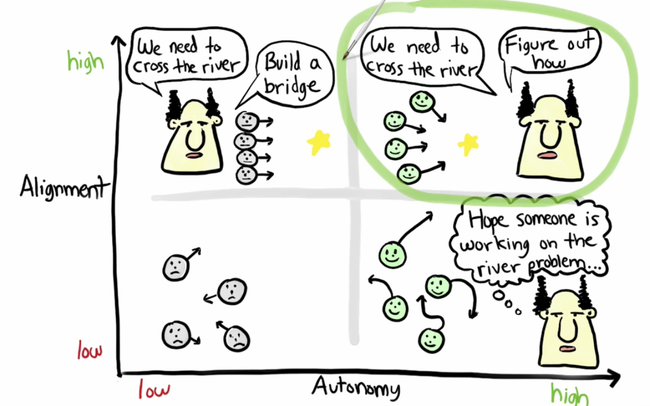
- Objectives make it clear: Where do we need to go? What’s the goal?
- Key Results help us understand: How will we know we are getting there?
- Initiatives / Tasks take most of our time: What will we do to get there? How do we spend our time?
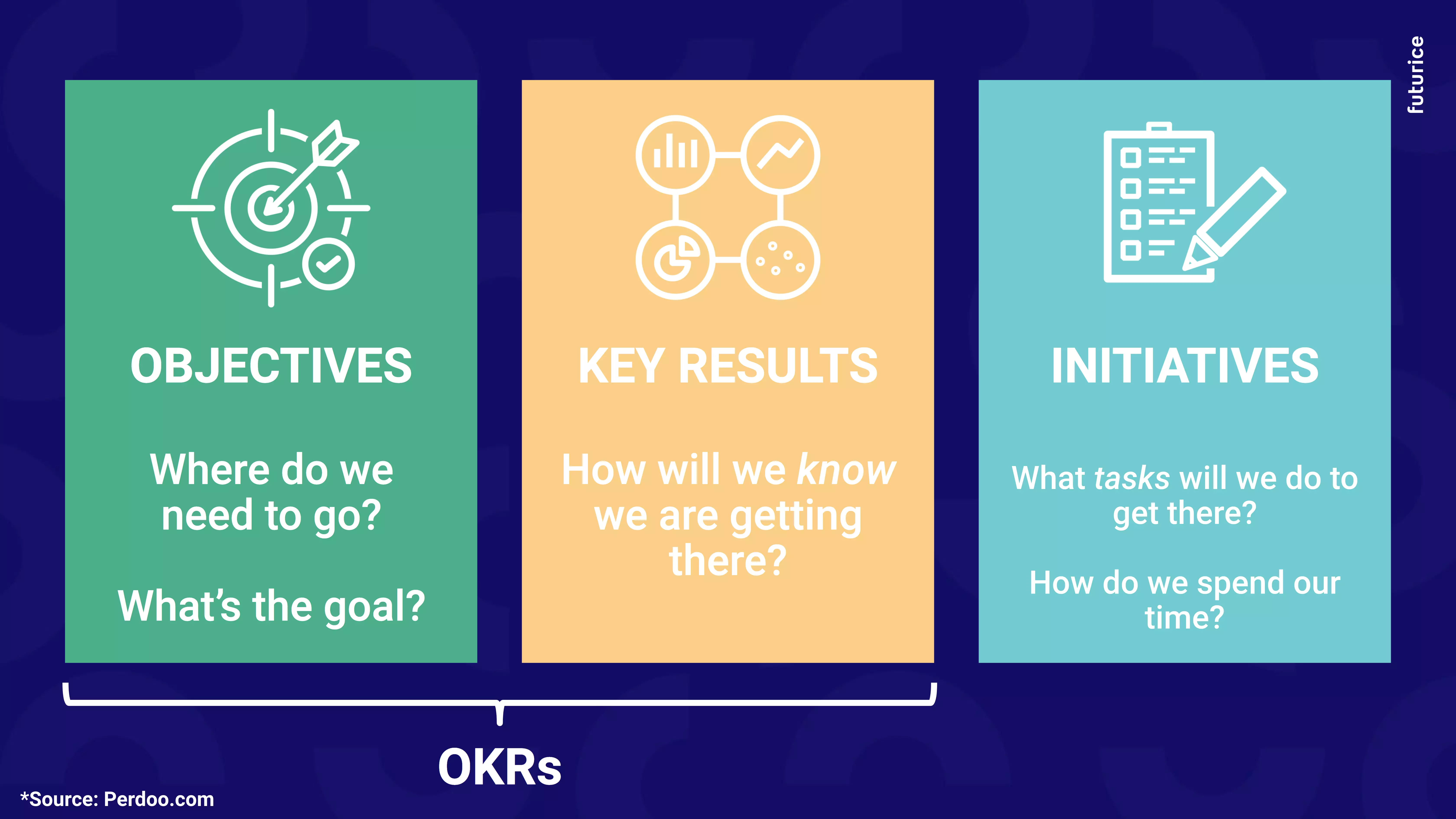
Let’s take a simple (non-business) example (modified from Perdoo)
OBJ 1: Get back in shape after holidays (= the goal)
KR 1: Decrease body fat by 5% (= how we know if we’re getting back in shape)
KR 2: Lose weight by 3 kgs (= how we know if we’re getting back in shape)
Initiatives: Run 20 km every week, go to the gym, eat less unhealthy food, prioritize sleep over binge-watching Netflix …
And here’s a more “business” example:
OBJ 1: Stronger relationships with our elderly customers
KR 1: NPS from 68 to 75
KR 2: Retention rate improves 10%
Initiatives: Hire new customer service employees, schedule meetings, update the website’s Q&A section, organize an event …
There are several best practises on how to write great OKRs, but that is something we can dive deeper into later on.
There’s a myriad of methods to set goals, but there’s a reason why this approach is used in companies like Netflix and Dropbox, while gaining increasingly more popularity (based on multiple conversations with our clients).
OKRs improve transparency dramatically. It gives visibility for both the company leaders and all employees on how the strategy execution is progressing. It is a cyclic system, not some separate goals in isolation. Often, OKRs also improve meaningfulness for individuals when being better able to connect one’s own work efforts to the company’s overall direction.
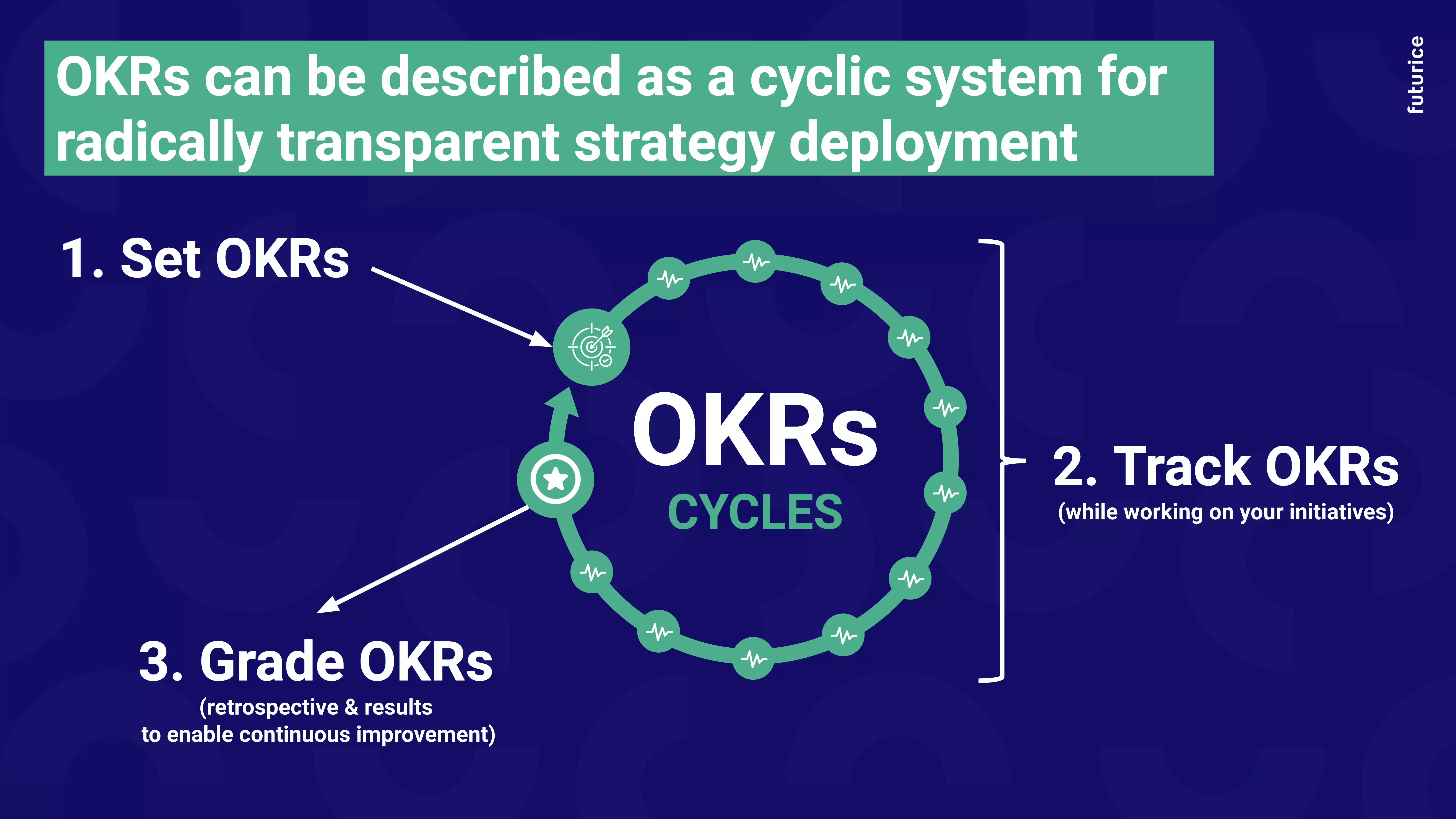
“Hmm, I’m still a bit puzzled.”
Well, we were very puzzled in the beginning as well, and partly still are. But hey, let’s cut to the chase — how have we approached OKRs so far here at Futurice?
First of all, as we’re focused on consulting (and we’re not a full-force product company), there are slightly different dynamics that affect the implementation: the majority of our employees are working most of their time together with our clients, following mainly the clients’ goals. But we do have multiple “not client teams” with clear responsibilities (e.g. certain people in tribes, marketing, human care, IT etc.) where it makes sense to use something like OKRs. So currently (April 2020), we have approx. 120 (of ~600) employees directly involved.
Secondly (although there’s still a lot to do in this area), we’ve approached the framework by acknowledging the need for two types of goals: OKRs and Health Metrics (in other words KPIs, Key Performance Indicators). With OKRs, we define what we need to actively push forward right now — we set, track and grade clear quarterly and biannual/annual goals. With Health Metrics, we mean the certain chosen performance indicators that we always need to protect, things that keep us going (related to clients, people & numbers). If there’s an identified challenge with certain Health Metrics, we might need to react immediately, and it might end up within our OKRs for the next quarter.
Thirdly, after validating multiple possible scenarios, we decided to start with team-based OKRs. There are organizations (like Google) where many employees are writing down their individual OKRs. In our context, the team-based approach (to our knowledge, also Zalando’s approach to OKRs) seemed like the best fit.
Fourthly, we’re currently deriving our company-wide OKRs biannually (possibly moving to annually) from our strategy. All other, like countries’, global and local teams’ OKRs, are currently following a quarterly cycle. So our "not client teams" set goals for themselves every three months, track their progress transparently on a weekly/biweekly basis (depending on the team) and have a retrospective minimum once a quarter to grade the results and learn from the past time box. ↺
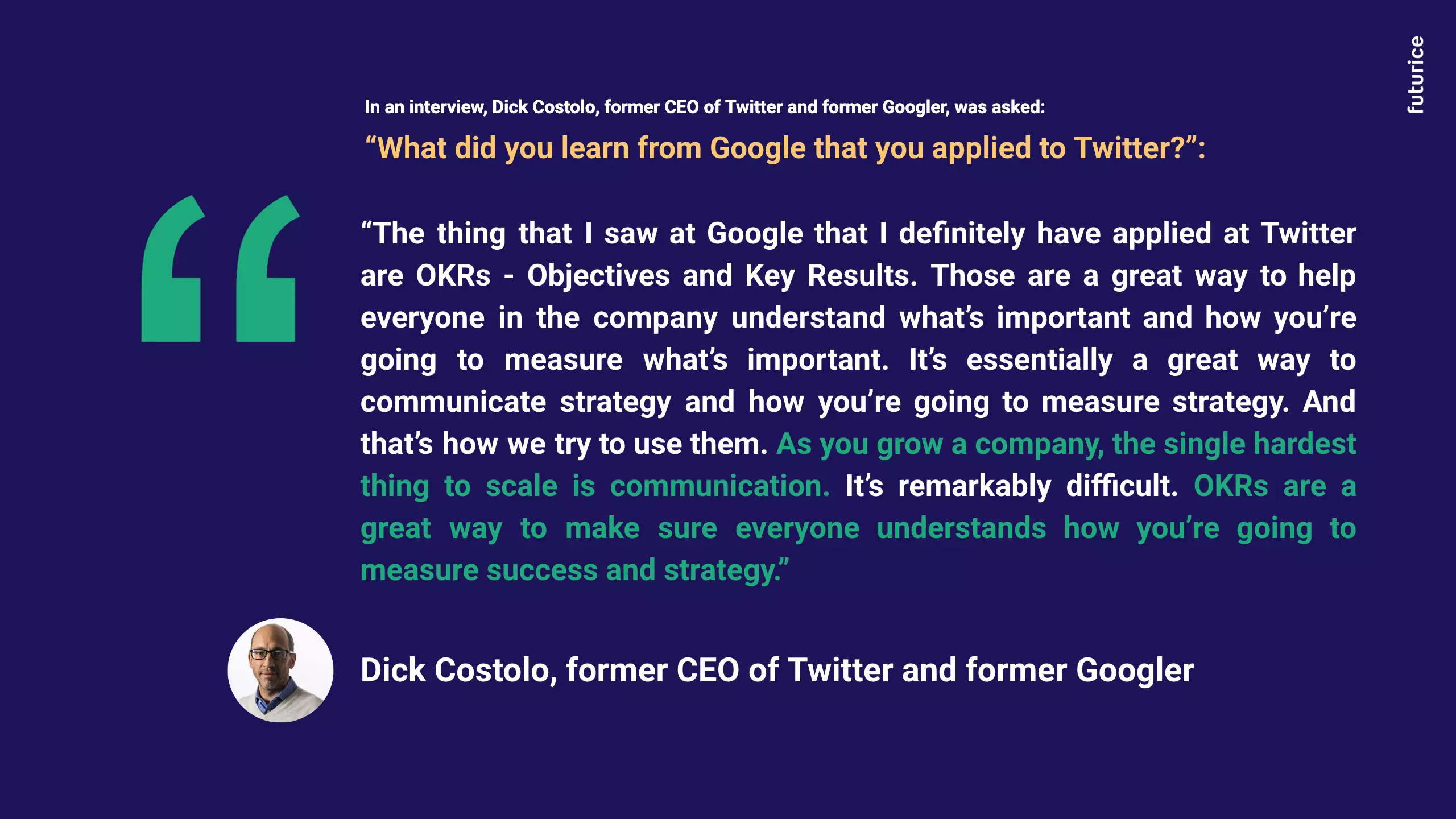
“Okay. Cool. Great stuff. Now could you be more precise — what exactly have you done?”
Of course! Here’s our ongoing OKRs journey’s timeline summarized (disclaimer, if you’re reading this blogpost in 2080s or something, our approach might have been changed since):
January 2019. Decision is made — let’s run an experiment with OKRs! Involving two small teams consisting of tribe leads and sales-focused people. Recruiting a person internally to lead the experiment & validation.
February 2019. Diving very deep into OKRs. Educating ourselves and building scenarios of the potential implementation — choosing to start with team-based OKRs and three layers. Crafting the first iteration of an internal guidebook that answers to the fundamental questions: Why? What? How? When? Why should I care? Having a short, a bit half-baked experiment with ~15 people.
March 2019. Preparing for the first proper experiment round, Q2/2020. Enrolling the first batch of people, 30+ futuriceans. Coaching, explaining, negotiating. Change management. Having tough conversations with people who felt concerned, uninterested or just “too busy for anything new”. Finally setting the first OKRs in a Google Sheets -based tool.
April 2019. Validation. Were OKRs creating value or just being a useless thing on top of everything else? How were the teams adopting the renewed way of setting, tracking and grading goals? Witnessing both successes and failures.
May 2019. Decision to move from experimenting to implementation is made based on positive feedback from the experiment participants. “By January 2020 onwards, we’ll run our business using OKRs” was stated by our CEO as an ambition to the whole organization. To get the true value out of it, we had to take the leap of faith.
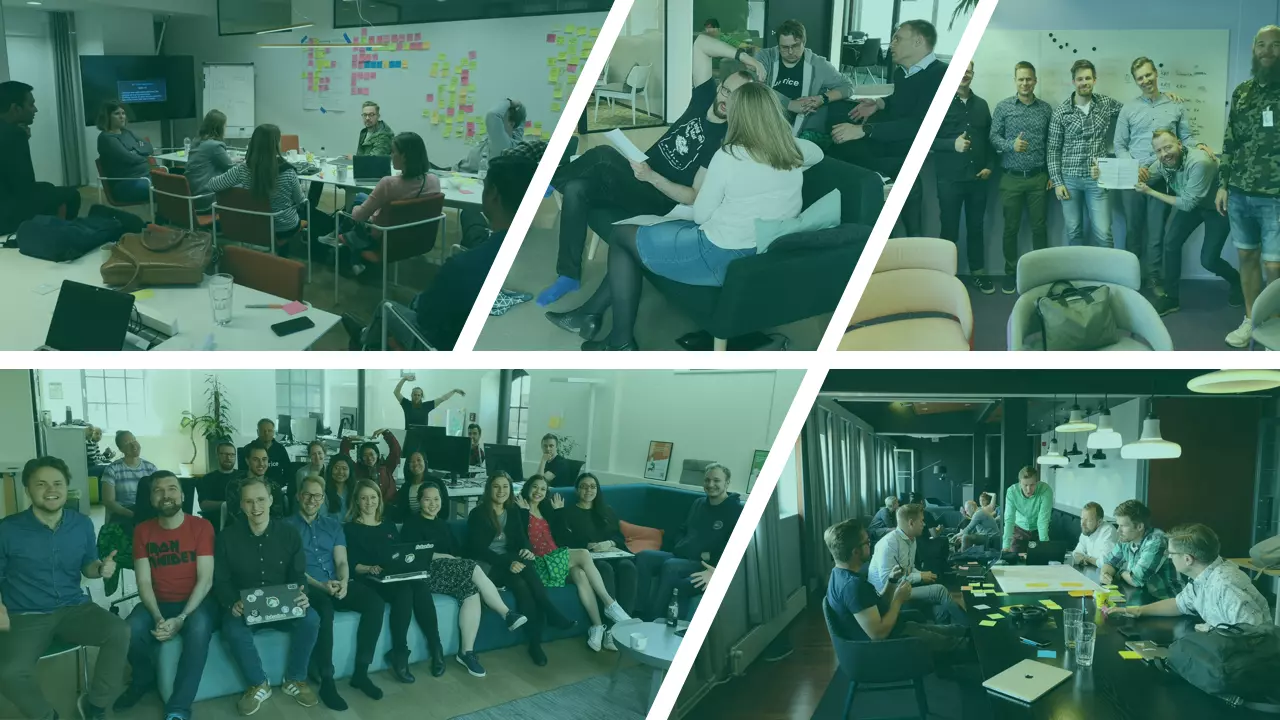
June 2019. Introducing new teams to the program. Grading Q2 OKRs. Setting company-wide OKRs for the first time for the next six months (H2). Involving two countries and a couple of teams. This setting was a truly painful process, where we missed some of the deadlines, but eventually got a decent set of objectives and key results in place. Or that’s how we felt back then ...
July 2019. Holiday season for the majority of people now involved (65+).
August 2019. Learning that many of the basic best practises were well forgotten during the holidays. Change takes time. And resilience.
September 2019. Onboarding new teams and countries. Grading (with somewhat proper retrospectives) the Q3 OKRs.
October 2019. Starting to use proper software (SaaS) to facilitate the program. Finalizing the focus for the last months of the year.
November 2019. Witnessing improved focus in many of the teams, but also in the enhanced conversations between the teams. Understanding that we need to still improve in writing better OKRs, while reducing the total amount of KRs. Say “no” to more endeavours that are not the most important ones for the next time period.
December 2019. Getting new teams on board: now all internal core teams (120+ people) were enrolled in the OKRs program — naturally with different levels of engagement and understanding. While grading Q4 and H2 OKRs, learning that many of our teams still need to improve in integrating the OKRs tracking into the teams’ habits. We set our focus for the first time box in 2020.
January — February 2020. Moving forward, slowly getting used to the rhythm. Some teams seem to be more ahead in integrating OKRs into their habits and self-leadership, but still teams / team members with challenges and demonstrated resistance to change. Some teams still with difficulties in prioritizing the chosen focus over whatever it is that feels urgent and comes ahead ad hoc. Learning things we need to improve in our internal communications. Reminding ourselves that change always takes some time!
March-April 2020. Updating our company-wide OKRs to support our focus during the upcoming months with the ongoing Covid-19 pandemic. Based on those, crafting Q2/2020 OKRs within countries, global & local teams. Currently, focus is on executing multiple initiatives to succeed with the chosen priorities. And here we are, writing this blogpost, to share with you our journey & insights so far.
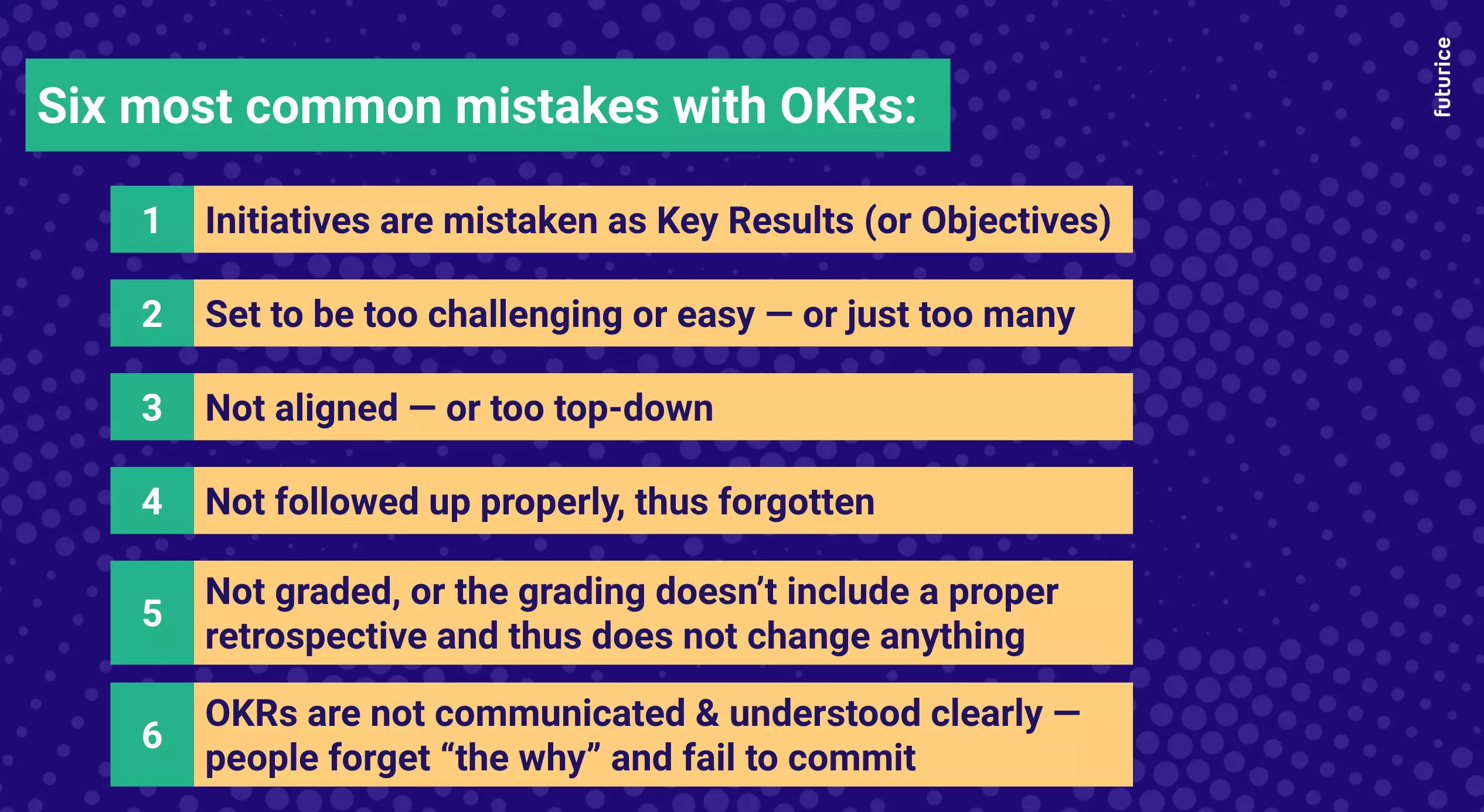
“Alrighty. In the clickbait headline, you told me there are some concrete tips here?”
Yes. Here you go:
16x insights — tips for using team-based OKRs in your organization:
1. Especially if you’re a first-timer with OKRs, it’s important to start by understanding and acknowledging what your organization’s current & desired leadership culture is like. How does it differ across the organization, e.g. in different countries and offices? Based on those realizations, craft scenarios of the potential approach to OKRs and its implementation. Be honest: what’s the current level of psychological safety — do your employees trust each other — or fall easily into micromanaging? How about people’s experience on the level of transparency and equality? A successful company-wide implementation of OKRs framework requires a healthy foundation in the forementioned. Nevertheless, don’t get stuck with your organization’s current challenges — but go and start experimenting — as OKRs implementation might serve you as a tool for contributing in improving those basic fundamentals of collaboration.
2. Find a “sponsor” from your top leadership, select torchbearer(s) and ensure that at least the majority of recognized key players are committed to experiment. An organization-wide implementation of OKRs approach requires investments and mental capacity especially from the leaders. Without these, you’ll likely end up with lip service. Require enough understanding and experience of business from the torchbearer(s), to integrate the OKRs as a natural continuum to your strategy process. It’s good to note here that even a small individual team might find OKRs useful in guiding the daily focus, but the real value comes from when you learn to use it to improve the alignment & focus of the whole ship.
3. Recognize that it’s a learning journey, not a quick sprint. Implementing OKRs will most likely require a change in the way you lead yourself and the organization. It’s about finding a sweet balance between autonomy and alignment. Requiring the goals to be clear and inspiring, but also measurable and transparent for everyone. It's about enabling everyone to make their voice heard. Instead of micromanaging initiatives — or being in complete darkness with the status of things — it requires trusting people to make smart decisions on what tasks to do to get to your company’s goals. We’ve been on the journey for over a year now — and by no means can we claim that we’re “ready” yet — but hey, at least we are learning, continuously! :)
4. Communicate the WHY actively, starting from the beginning. Make transparent and accept the challenge your organization is aiming to improve / fix with implementing the OKRs approach. Clarify the answer from both perspectives: “Why are we doing this?” (organization) and “Why should I care?” (individual). Then remember to repeat it. This’ll help you in getting the buy-in from the leaders. It’s easier to start experimenting and continue to full-scale implementation, when the problem worth solving is identified, validated, accepted and communicated transparently.
5. Use a mixture of communication channels and invest in a proper OKRs tool. Back in the 1970s, Andy Grove & employees at Intel used to have their OKRs written down on sheets of paper, attached next to their desks. And in all its simplicity, it worked. Today, online communication is the default, but the required change communication might get lost in the endless stream of emails and Slack messages. At Futurice, we’ve found it helpful to invest in a proper SaaS tool (started originally with Google Sheets, then shifted to Betterworks). In addition to the tool and continuous communications via our digital channels, we’ve used old-school printed OKRs canvases in our premises, infoscreens with real-time data, all-hands meetings etc. One can always improve communications!
6. When setting OKRs, you need to make hard choices on what things you don’t do now. Make it clear — what is going to be left to the backlog and why — and then make the backlog transparent. The OKRs setting should lead to tough and even uncomfortable prioritisation discussions: people tend to feel their plates are already full or things that are both urgent and important. Amazon’s “disagree and commit” is often a good principle, when your team has too contrasting opinions on what things should be a top priority.
7. Avoid framing Objectives as generic headlines under which you bundle various loosely related metrics. In our approach, we believe your Objectives should be inspiring, time-bound, strategic changes you aim to prioritise. Key Results are different means to make that strategic change measurable. (Our 9-step criteria for Objectives: 1. Directional, 2. Aligned, 3. Challenging, 4. Within your circle of influence, 5. Time-bound, 6. Without numbers, 7. Limited, 8. Inspirational, 9. Easy to understand).
8. Optimally, Key Results should measure true outcomes, like the change of human behaviour (e.g. client, employee, stakeholder X). KRs shouldn’t measure initiatives A, B and C or outputs — but the expected outcomes of those initiatives. Best KRs are simple and easy to measure. Though when measuring outcomes, it's natural that the results start realizing towards the end of your time box — so it's important to discuss your teams' confidence levels for meeting the OKRs. If you can’t measure your KR, your follow up meetings easily become dull, fruitless and discouraging status update meetings. Shoddy follow ups often lead to lower success. Prioritize leading metrics over lagging metrics! (Our 8-step criteria for Key Results: 1. Guides you toward the objective, Measurable, 3. Outcome-based, 4. Balanced, 5. Ambitious, 6. Time-bound, 7. Limited, 8. Simple)
9. Don’t overestimate your team’s / organization’s ability to execute. In our case, we recommend our teams to choose max. 2-3 objectives with max. 8 KRs in total for the time box. Usually less is more.
10. Use a negotiation approach — both “bottom up & top down”. Ensure enough alignment to the organization’s other relevant OKRs, but ensure motivation by empowering each team to add their own flavour. Help everyone to understand “what good looks like” with clear company-wide OKRs, but try to avoid cascading initiatives / tasks — trust your people to find the right ways to cross the river (referring to the Spotify’s picture above).
11. We believe each set of OKRs should be owned by a clear team which meets regularly. And each Key Result (under each Objective) should have a named individual owner within the team (if the responsibility is unclear, it often ends up being neglected — the same happens if all the KRs are de facto owned only by the “team lead”). The owner needs to stay on top of what’s going on with the KR (update the progress, ensure all appearing bottlenecks are being solved, execute and/or delegate the necessary initiatives — hustle — to enable the team to reach the target value).
12. If the team isn’t able to own the OKRs logically, or if the KRs pile up to the same few individuals, this is potentially a problem in the team setup. Are we having all the right people on board to reach our aspirations?
13. Integrate OKRs tracking discussion to each team’s regular weekly/biweekly meetings. Get a proper SaaS tool to enable this. Focus on the Key Results that are not moving forward and agree on a plan to start unblocking them. Naturally, your OKRs don’t express everything your team does. But if the majority of initiatives your team does are not helping to progress with your OKRs, you’re probably doing something wrong.
14. As in any agile methodologies, the short time box is usually strict and has a clear focus. Stick to it and demand the same from your colleagues! Avoid continuously coming up with new activities and priorities — otherwise you’ll lose the focus quickly and get much less done.
15. Don’t belittle the importance of OKRs grading! Grading is perhaps the most important part of the OKRs cycle. Primarily, grading should be a retrospective to learn from your successes and mistakes to change your actions — and secondarily a way to make the results transparent.
16. When getting started, in communications, it’s good to highlight, explain and repeat the acronym “OKRs”. But the deeper to the rabbit hole you get, it’s more important to use the Objective’s and/or Key Result’s actual content and less the acronym “OKRs”. When your organization starts to get used to the rhythm, talk more about the goals and your progress, and less about the process itself.
To be honest, it’s likely that we could make a list of 50+ insights. But here were some we have currently on top of our mind. So ...
… Every grrrrreat social media post should have a clear call to action, right?
*Recommended to read this out loud with a low, dreamy, but convincing voice: *
Has your organization been wondering:
How to really get from strategy to execution?
How could we become more transparent and aligned together?
How could we enable focus in these turbulent times?
Futurice has now gathered some first-hand experience — don’t hesitate to get in touch to learn more. And yeah, it's still an ongoing learning journey for us too!
Focus on what matters most,
-Viljami & Olli-Pekka
Viljami Väisänen // viljami.vaisanen@futurice.com
Olli-Pekka Saksa // olli-pekka.saksa@futurice.com
 Viljami VäisänenManager, Strategic Development & Deployment
Viljami VäisänenManager, Strategic Development & Deployment Olli-Pekka SaksaVice President, Family Lead
Olli-Pekka SaksaVice President, Family Lead

